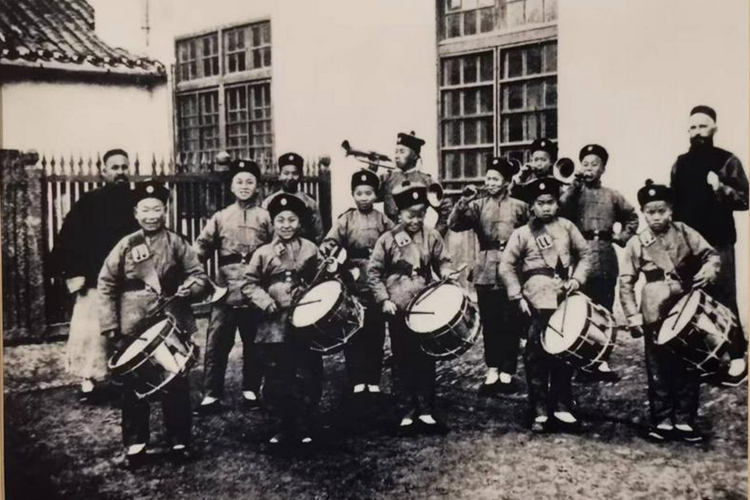Recently, I attended the Modern Music Education Literature Exhibition of Shanghai T'ou-Sè-Wè Museum, learning that foreign missionaries and a group of orphans promoted the spread of Western music to the east in T'ou-Sè-Wè Orphanage, which was also the cradle of Western painting in China.
Besides the T'ou-Sè-Wè Craft School for orphans, the priests established T'ou-Sè-Wè Orphanage in 1864. Batches of homeless and destitute orphans not only survived but also became outstanding figures in diverse fields such as painting, sculpture, carving, printing, and stained glass making.
From 1900 to 1940, the orphans' craftsmanship, including woodworking, painting, weaving, and metalwork, won four awards in seven World Expositions. Particularly notable was the 1915 Panama-Pacific International Exposition in San Francisco, where the "Xujiahui Orphanage" was awarded three medals at once. Among them, the "T'ou-Sè-Wè Pagoda" received the grand prize at the World Exposition.
During my second visit to the T'ou-Sè-Wè Museum, I unexpectedly encountered the exhibition, which runs from May 17, 2023, to December 31, 2023.
During Matteo Ricci’s mission in China, European music began to enter China. However, Western music becoming a popular and well-received art form in China started with Xujiahui in the 19th century.
As early as 1858, Xuhui Public School (College) had the first modern Chinese west wind ensemble, founded by Franciscus Ravary S.J. This band predated the Shanghai Public Band (predecessor of the Shanghai Symphony Orchestra) formed by foreign personnel by 20 years. Ravary S.J. took over as the choir director of Xuhui Public School in 1856.
In April 1864, the construction of the T'ou-Sè-Wè Craft School began, and the orphans from the old city temporarily resided near Xuhui Public School to avoid an epidemic. Ravary S.J. was responsible for the placement of orphans, who began to participate in the band.
The craft projects at the craft school included not only painting, woodworking, carving, printing, shoemaking, tailoring, and painting but also the manufacturing and repair of musical instruments. Although the craft school stopped producing large pipe organs after the director of the school, Leopaoldus Deleuze, passed away, it laid the foundation for Western music education and the making of Western instruments.
Afterward, even though Ravary S.J. was transferred from Xujiahui, Chinese members of the band continued to recruit students at the public school and craft school, persisting in music education. In October 1871, they performed Haydn's Symphony in the presence of the Austrian Consul in Shanghai, astonishing and moving him.
In 1903, the T'ou-Sè-Wè was officially established, playing Western music once again.
The instructors of the band had high musical cultivation. Macanese Portuguese Francesco Xavier Diniz was one of the founders, having graduated from Shanghai St. Francis Xavier's College (Beihong Senior High School). He was proficient in music theory and could play different instruments like the violin, trumpet, and clarinet. He collected the earliest batch of instruments from the Portuguese community in Hongkou District, where he grew up.
To teach students music theory, Xavier Diniz and Shanghai native Zhang Shishu co-authored "Western Music Q&A in Shanghainese." Xavier Diniz provided oral explanations, and Zhang recorded them in Shanghai dialect. This was the earliest teaching material on Western music in modern Shanghai. Xavier Diniz also secured a fixed rehearsal space for the craft school's band.
The second leader, Joseph Damazio, played the French horn, while his successor, Xavier Coup, a French Jesuit, played the organ. In April–May 1907, the Frenchman Louis Hermand introduced the saxophone to the band, marking the earliest record of a Chinese person learning the saxophone.
The instruments of the band mainly included trumpets, French horns, trombones, tubas, clarinets, saxophones, and snare drums, which were all imported from France.
The band was the "top brand" in this area at the time. Whenever domestic and foreign dignitaries visited Xujiahui, it would perform prominently to entertain them. Western music became popular starting in T'ou-Sè-Wè. The spread of the music education model represented by the band has played a role in enlightening and promoting the development of modern music education in China.
In 1953, the Shanghai Civil Affairs Bureau took over the craft school, which ceased to admit orphans. From 1958 to 1963, a variety of workshops at the school were transferred to other facilities, marking the end of the history of the band.
(Source: Modern Music Education Literature Exhibition of Shanghai T'ou-Sè-Wè Museum)
- Translated by Abigail Wu












